Original URL: https://www.theregister.com/2013/09/04/review_tascam_cda750_compact_cassette_recorder_cd_player_combo/
Decks and plugs and rock and roll: Tascam CD-A750 cassette and CD combo
I'll give you my tapes when you pry them from my cold, dead hands
Posted in Personal Tech, 4th September 2013 09:03 GMT
Anniversary review The recent El Reg feature on the Compact Cassette's 50th birthday had many a reader commenting on some of the format's former glories. Names mentioned among the dewy-eyed included Aiwa (a favourite in UK studios) and the audiophiles’ choice, Nakamichi, with both producing state-of-the-art recorders with three heads and a lot more besides.
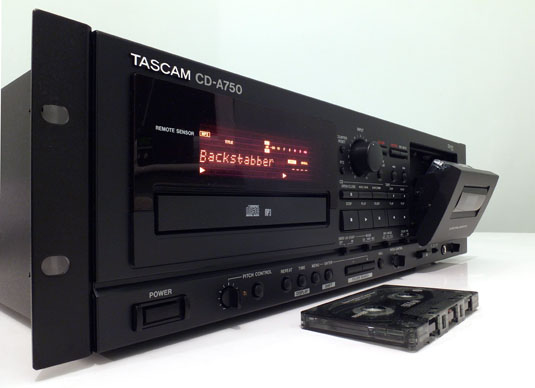
Winning combination? Tascam's CD-A750 compact cassette deck and CD player
Admittedly, these days, the format is as good as dead, but with so much material recorded on cassette, there remains a need to be able to play the content even if it is just to transfer it to a digital format. A few companies continue to supply cassette recorders in various guises from pocket friendly cassette-to-USB gadgets for 20 quid or less to rather more sophisticated offerings for a good deal more.
Teac makes some interesting models that have a CD-writer and cassette combo, but one of the shortcomings that rears its ugly head here is that only audio CDs can be used for recording. Not all CDs are created equal, and the writeable audio version is effectively tagged as OK for Hi-Fi use, and costs more - an indiscriminate copy tax. The Tascam CC222SL mkII is more forgiving, but to use any writable CD, you have to pay for the privilege – it's £879.
So rather than get all hot and bothered about that money grabbing legacy of the Audio Home Recording Act (AHRA), a purist approach seemed appropriate. Forget the CD burning, let's focus on the cassette recorder itself. And as it happens that decent models tend to be paired with optical drives, what we have here with the Tascam CD-A750 is a player that doesn't make a fuss about CD formats and will play whatever you stuff into it, including MP3 discs.
Tascam, the Teac professional division, does endeavour to show some studio credibility with the CD-A750. This model looks the part with its rack mounting ears and a peek around the back reveals XLR connectors for +4dBu professional balanced line level interfacing. It also features RS-232 and parallel connectivity, for a range of machine control options that go beyond the infrared handheld remote supplied with the unit.
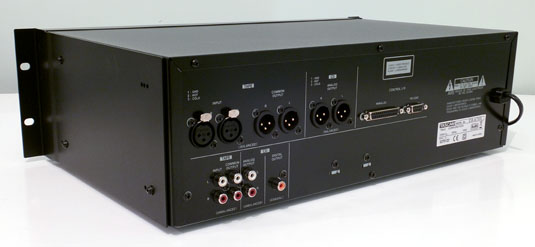
Rack mountable with balanced XLR audio connectors plus RS-232 and parallel control capability
It's this attention to detail that is likely to see this model installed for education, galleries and even boardroom purposes so that slick operation from something like a Crestron or Extron control panel can be enabled.
Would you really want to go to these lengths for cassette use though? Well, maybe CD playback would be the more obvious choice, but if you were busy transferring copious quantities of cassette content for repurposing on digital media, then hooking up some kind of machine control from your digital audio workstation is going to be favourable to pinkie prodding panel games or waving a remote around.
Tascam provides detailed information on how to get the RS-232 side of things all up and running here, with the owner's manual outlining parallel port use. The latter has tally options – a feature which enables remote status lights to be configured in the setup. So that's some of the quirky stuff the CD-A750 has available, what else?
Quiet times
As far as the cassette deck is concerned, personally, it's disappointing to see only Dolby B supported here. Yes, it was the most widely used noise reduction system and dominated Musicassette duplication. Still, Dolby C, which if memory serves me right never appeared on mass produced titles, nevertheless became a feature on all decent hi-fi decks and, being an improved system, was used by many taping enthusiasts. OK, so I have a load of stuff with it on and I'm sure I'm not alone. Dolby B can be used for Dolby C playback instead, but isn’t ideal.
Alas, there's no escaping the fact that this deck doesn't match the technical prowess of a bygone era. You won't find three heads here – record (sync), playback and erase – just the usual doubling up of record and playback duties on the one head with an erase head too, of course. Also, Metal tapes can only be replayed, not recorded, which seems a bit remiss.
For chromium dioxide tapes, the frequency response figures in the manual quote 50Hz~12.5kHz ±3dB. Maybe I’ve spent too long in the digital domain but this doesn’t look very impressive. A nose at the spec of the Tascam 122 mkIII, a stalwart studio offering from yesteryear, shows similar output variations yet a vastly improved frequency response: 25Hz~19kHz ±3dB with a CrO2 tape.
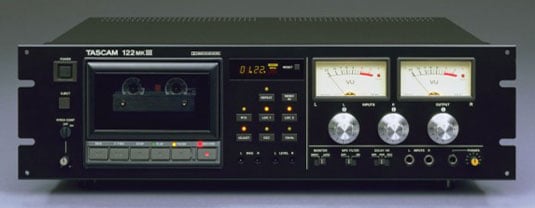
Hero of the age: Tascam's 122 mkIII compact cassette deck was pretty much an industry standard in studios
It’s an interesting comparison because there are similar remote and professional audio interfacing options on this old model and it also scores highly with its flutter spec. This measurement determines how reliable the playback speed is and how prone it is to minor variations – in effect, frequency modulation.
On the old 122 mkIII, flutter is down to 0.04% whereas the CD-A750 clocks up a mildly seasick 0.25%. Much above 0.3% and people start to notice, and 0.4% was the limit specified by Philips 50 years ago, so this figure gives the impression that Tascam isn't trying very hard here.
The analogue age
That said, unless you’ve an audiophile collection of tapes and a dead deck of repute to replace, these spec differences aren’t going to be too obvious, as the chances are the gear the tape recordings were made on in the past didn’t fare much better than the CD-A750’s deck.
The shocking part is that you might have assumed advances in technology would allow for an improved performance over gear dating back a couple of decades. Yet it seems things are different in the analogue domain and that the digital distillation that makes things smaller, faster, cheaper and better doesn’t apply here.
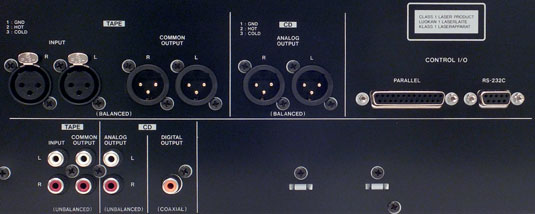
A solitary coaxial digital output delivers CD audio to other digital devices
I might be being a tad ungenerous here, but it would appear that Tascam has bolted on a budget deck to a half-decent CD player and consequently potential buyers assume this is the mutt’s nuts, as it includes pro audio analogue interfacing and some remote control functions. It certainly gives the impression that it’s made to be taken seriously, but the model with the best spec Tascam still produces is the double-decked 202mkV and its Teac equivalent, the W-890R. Neither has the XLR connectivity though.
Perhaps this browbeating is a little harsh and a reality check is in order, as the cassette tape is a has-been technology. Those digital boons of better and cheaper only occur on products that are actively being developed and who is busy doing R&D on cassette recorders these days? Any names spring to mind?
If you’re thinking of Ion Audio, these products are aimed at format transfer convenience rather than a serious effort for archivists; you won’t find Dolby on an Ion deck, just a generic noise reduction function.
So let’s ignore the specs at this time and just embrace the fact that you can still buy a brand new, fully functional cassette deck in 2013, that’s a fairly recent model too, as Tascam announced the CD-A750 back in 2009.
Basic instinct
In use, it’s funny how quickly old habits start to kick in, as I wound back a slightly slack pre-recorded tape with my little finger pressed against the sprocket, without giving it a second thought. Inserted and ready to play, familiar mechanical noises greeted my ears as the tape heads clunked into place.
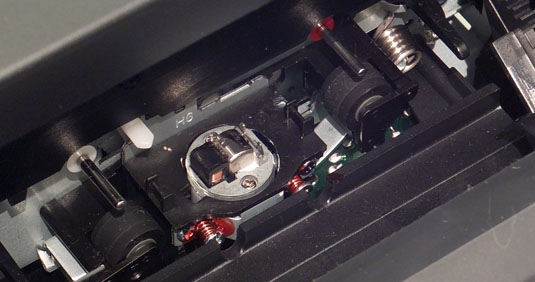
The recorder heads rotate to enable continuous recording when the cassette tape is auto reversed
As for fast-forward and rewind, these functions instantly gathered up any slack with a clack as the spool began whirring away sounding like a muted sewing machine with occasional rattles adding to the mix. You forget how long these tapes take to get from one end to another. A couple of minutes for a C-90 – what did people do with the time?
Playing an aged Musicassette of Roxy Music’s Greatest Hits (1972-1975) was a pleasure in itself, and this Dolby B tape still sounded strong even though it had been manufactured at least 20 years ago. It’s difficult to make a definitive judgement on performance here because there isn’t the source to compare it to. So what I found most striking – a somewhat contained stereo image – may, in part, be a consequence of how it was originally mixed.
Tape noise didn’t seem too much of an issue and drop-outs were virtually non-existent. The latter typically experienced when there have been previous tape handling grubbibess or the occasional capstan chew.
Obviously, an easy way to test playback against a source is to do some recording from the CD player and I began with Goldfrapp’s Seventh Tree which has its dynamic moments. Again, those instincts kicked in, as I hunted around for the loudest part of the track, checking the metering in order to set recording levels that wouldn’t overload and distort on this analogue media.
Here, playback comparisons had a je ne sais quoi about them. A quick and dirty frequency response test using RTA’s iPhone app suggested similar levels across the board. It was hardly a scientific analysis and I’d say the definition suffered here, which could be the tape I was using, the recorder or just a consequence of recording on analogue tape and the noise inherent in this process. Indeed, switching from a ‘normal’ ferric oxide to a chromium dioxide tape was a marked improvement here but still a bit muddy in the mid-range.

The CD player can display MP3 track names and artists
I tested out recording a variety of music being sure to remember to check for levels, listen to song fade outs whilst taping and to press pause just before the next track kicked in. There was a craft to home taping that’s definitely been lost, but not easily forgotten if you grew up with it. I did other tests with the recordings, trying them out on my remaining cassette decks – a Philips DCC 900 (digital compact cassette deck) and an old Panasonic RQ-2734 portable from 1976. On both systems, nothing stood out as extraordinary, which is a good thing.
Legacy issues
I was pleased that the CD player lived up to its billing and handled non-CD audio discs without complaint. It will also replay MP3 and .WAV files on disc. I tried out an MP3 compilation which featured over 140 tracks. The remote control comes in handy here to type in track numbers for playback. You can also see track names and artist and dive into different folders both the remote and the front panel.
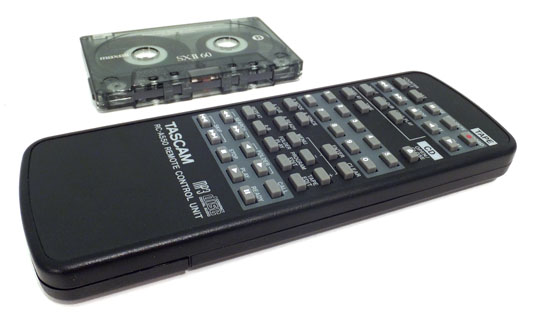
Apparently there a 55 buttons on this remote – it's a bit on the big side
A neat feature adorning both the CD player and the tape deck are their separate pitch control (varispeed) knobs. You can vary the CD playback by ±12.5% and the cassette playback by ±10%. I had hoped I could get a super slow playback effect by setting the CD to its lowest speed and recording with the tape deck set to its highest speed. Afterwards, normal playback on the cassette deck would then sound slower still. However, it seems that varispeed tape recording is not permitted, perhaps with good reason.
That aside, varispeed is useful for tuning purposes and, in non-pitch critical situations, enables playback duration to be tailored to fit. Got an archived sermon tape to get through for a restless congregation? The varispeed could be a godsend.
Remote access
The Tascam CD-A750 remote has a number of other features for cueing, repeat playback and even a continuous playback alternating between the CD player and the tape deck. A dubbing mode automates CD recording and sets a default level which can be adjusted too. The remote is absolutely littered with buttons and destined to become a constant companion.
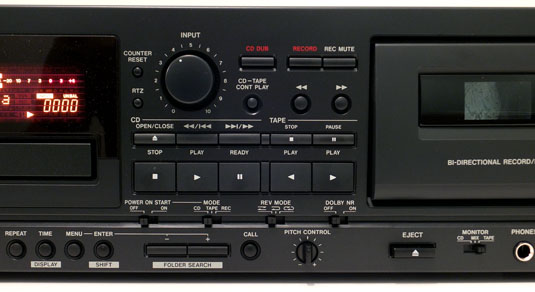
The transport control layout isn't the most obvious on the cassette side of things
I say this because the biggest jolt when using the tape deck was the layout of the transport controls. The tiny fast-forward and rewind buttons defied logic and I was frequently tapping the forward and reverse play buttons by mistake. The remote makes it all a lot clearer.
Overall, the CD-A750 acquitted itself well and it has a number of useful features that you’ll be hard pressed to find elsewhere. I wondered if Tascam had any bespoke apps or suggestions for the RS-232 and parallel interfacing but the best it could come back with was that “it should work with any third-party controllers via the RS232 port.” Well that was an insightful response, thanks guys. Those Crestron and Extron links earlier give an idea of what can be done, iPad control is probably an option through various means.

Sellers' market? With so few alternatives, there's a price premium on these Tascam and Teac offerings
The Reg Verdict
It's probably fair to say that Tascam's main focus is on other products that are more of the moment. Its tape deck portfolio sales are no doubt rather niche these days, which may well explain the price. The CD-A750 costs £699, which seems extremely high given that this is no audiophile tape deck and the CD unit is a player only.
If you’re happy to forego the balanced XLR interfacing and the serial and parallel connections, the CD-A550 is the otherwise identical alternative for £525. And if the CD isn’t important either, then the double deck 202 mkV is probably your best bet at £415.
Whatever your preference or intended purpose, there’s not a lot out there to choose from regarding alternative manufacturers. So if you’re after new compact cassette equipment that’s more than a toy, then it seems Tascam and Teac have got it taped. ®